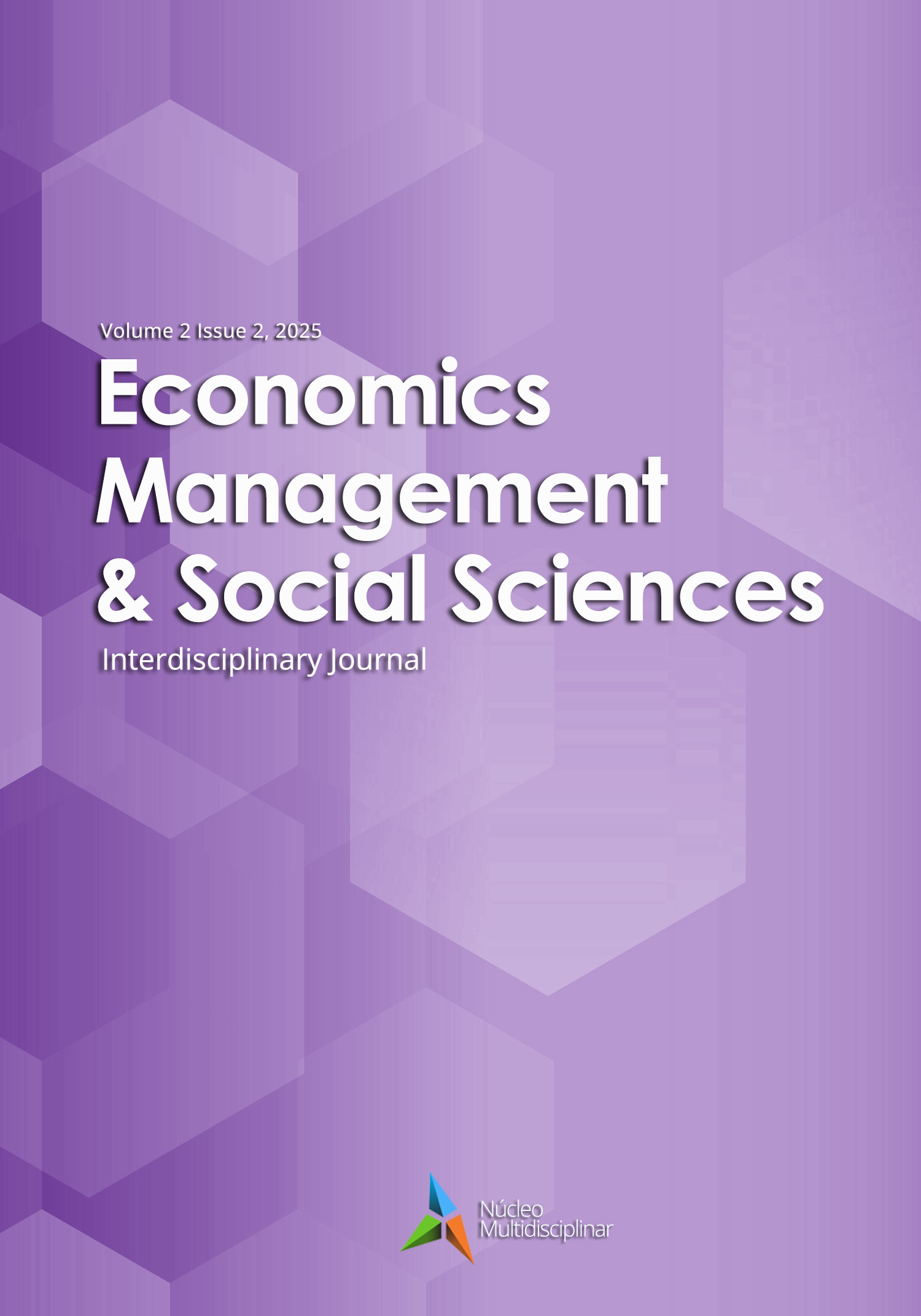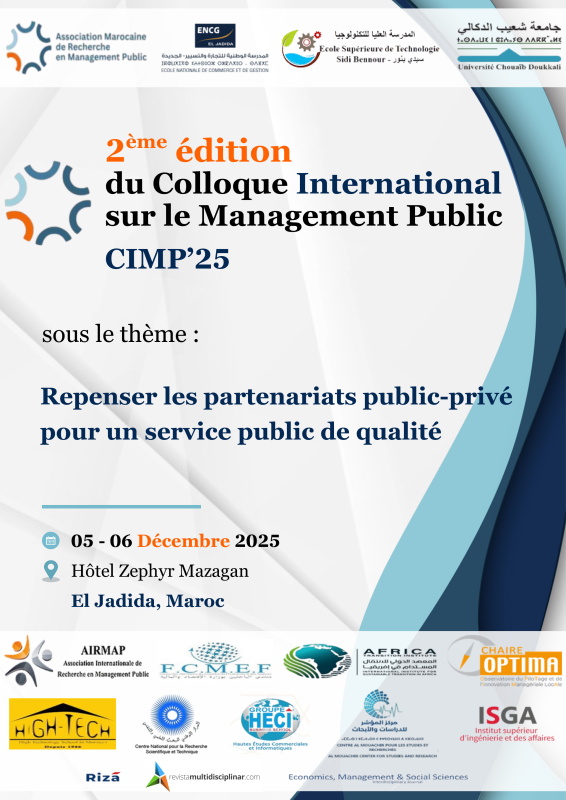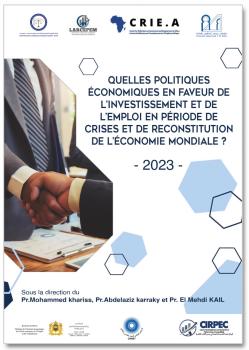l'Intelligence Artificielle au service de la conception d'affiches publicitaires
Une étude exploratoire au Maroc
DOI :
https://doi.org/10.23882/emss25167Mots-clés :
Intelligence artificielle, Affiches publicitaires, Personnalisation, Engagement des consommateurs, Etude qualitativeRésumé
Cet article explore l'utilisation de l'intelligence artificielle (IA) dans la conception d'affiches publicitaires au Maroc, en mettant en avant les points de vue des acteurs du secteur. À travers une étude qualitative, l'analyse met en lumière les opinions variées des professionnels concernant les impacts, les défis et les opportunités que l'IA pourrait apporter dans le domaine publicitaire. Les résultats montrent que l'intégration de l'IA a le potentiel d'accroître significativement la créativité et l'efficacité des campagnes en permettant une personnalisation des messages et en optimisant l'engagement des consommateurs. Cependant, l'adoption généralisée de ces technologies fait face à plusieurs obstacles, notamment les coûts élevés associés à ces innovations et la nécessité d'une expertise spécialisée. Par ailleurs, des préoccupations éthiques surgissent, notamment en ce qui concerne la transparence et l'utilisation des données personnelles.
Cette recherche contribue à une meilleure compréhension des avantages et des limites de l'IA dans le paysage marocain et soulève la nécessité de mener des études supplémentaires pour favoriser une adoption responsable et bénéfique de l'IA dans la conception de l’affiche, tout en indiquant l'importance de maintenir la dimension humaine dans un secteur en constante évolution technologique.
Références
Acemoglu, D., & Restrepo, P. (2018). Artificial intelligence, automation, and work. In The economics of artificial intelligence: An agenda (pp. 197-236). University of Chicago Press.
Azumah, D. M. Y., Hinson, R. E., Nukpezah, D., & Yiran, G. A. B. (2021). Visual Pollution Through Excessive Outdoor Advertisements. Marketing Communications in Emerging Economies, Volume I: Foundational and Contemporary Issues, 193-228.
Babatunde, S. O., Odejide, O. A., Edunjobi, T. E., & Ogundipe, D. O. (2024). The role of AI in marketing personalization: A theoretical exploration of consumer engagement strategies. International Journal of Management & Entrepreneurship Research, 6(3), 936-949.
Bessen, J. (2019). Artificial intelligence and jobs. The economics of artificial intelligence: an agenda, 291.
Bostrom, N., & Yudkowsky, E. (2018). The ethics of artificial intelligence. In Artificial intelligence safety and security (pp. 57-69). Chapman and Hall/CRC.
Brynjolfsson, E., & Mcafee, A. N. D. R. E. W. (2017). Artificial intelligence, for real. Harvard business review, 1, 1-31.
Chmielewski, S. (2021). Towards managing visual pollution: A 3D ISOVIST and voxel approach to advertisement Billboard Visual Impact Assessment. ISPRS International Journal of GeoInformation, 10(10), 656.
Cuc, S., & Secan, C. (2024). Environmental considerations and sustainable solutions for outdoor advertising banners. Sustainability, 16(13), 5366.
Delipetrev, B., Tsinaraki, C., & Kostic, U. (2020). Historical evolution of artificial intelligence.
Deuze, M. (2009). Convergence culture and media work. Media industries: History, theory, and method, 144-156.
Doherty, S. J. (2019). ART in the age of artificial intelligence. Esse, 97, 30-41.
Duan, Y., Edwards, J. S., & Dwivedi, Y. K. (2019). Artificial intelligence for decision making in the era of Big Data–evolution, challenges and research agenda. International journal of information management, 48, 63-71.
Duarte, F., Casimiro, F., Correia, D., Mendes, R., & Ferreira, A. (2013, December). Waynergy people: a new pavement energy harvest system. In Proceedings of the Institution of Civil Engineers-Municipal Engineer (Vol. 166, No. 4, pp. 250-256). Thomas Telford Ltd.
EL FILALI, S. B. (2020). L’affichage publicitaire dans la ville de Casablanca : état des lieux. Organisation et Territoires.
El-aasy, H. A. (2023). Employing Artificial Intelligence (AI) Technology in Advertising Design on Social Media. Journal of Design Sciences and Applied Arts, 4(2), 247-263.
Eldesouky, D. (2024). Artificial Intelligence and its Application in 3D Outdoor Advertising Design (A futuristic vision in the field of Advertising in Egypt). مجلة العمارة و الفنون و العلوم الإنسانية.
Englert, F., El'Hindi, A., Burgstahler, D., Alhamoud, A., & Steinmetz, R. (2014, June). Reducing the electricity consumption of largeoutdoor LED advertising screens. In Proceedings of the 5th international conference on Future energy systems (pp. 209-210).
Ergen, M. (2019). What is artificial intelligence? Technical considerations and future perception. Anatolian J. Cardiol, 22(2), 5-7.
Flowers, J. C. (2019, March). Strong and Weak AI: Deweyan Considerations. In AAAI spring symposium: Towards conscious AI systems (Vol. 2287, No. 7).
Gao, B., Wang, Y., Xie, H., Hu, Y., & Hu, Y. (2023). Artificial intelligence in advertising: advancements, challenges, and ethical considerations in targeting, personalization, content creation, and ad optimization. Sage Open, 13(4), 21582440231210759.
Gavaghan, C., Knott, A., & Maclaurin, J. (2021). The impact of artificial intelligence on jobs and work in New Zealand. Dunedin: University of Otago, New Zealand Law Foundation. Available online: https://philpapers. org/archive/MACTIO-49. pdf (accessed on 23 December 2023).
Hanna, D. M. (2023). The use of artificial intelligence art generator “midjourney” in artistic and advertising creativity. Journal of design sciences and applied arts, 4(2), 42-58.
Hendon, D. W., & Muhs, W. F. (1986). Origins and early development of outdoor advertising in the United States. European Journal of Marketing, 20(5), 7-17.
Ho, C. Y., Lin, H. T., & Huang, K. Y. (2012). A study on energy saving and light pollution of LED advertising signs. Applied Mechanics and Materials, 121, 2979-2984.
Huang, C., Zhang, Z., Mao, B., & Yao, X. (2022). An overview of artificial intelligence ethics. IEEE Transactions on Artificial Intelligence, 4(4), 799-819.
Jarrahi, M. H., Kenyon, S., Brown, A., Donahue, C., & Wicher, C. (2023). Artificial intelligence: A strategy to harness its power through organizational learning. Journal of Business Strategy, 44(3), 126-135.
Jatobá, M., Santos, J., Gutierriz, I., Moscon, D., Fernandes, P. O., & Teixeira, J. P. (2019). Evolution of artificial intelligence research in human resources. Procedia Computer Science, 164, 137-142.
Korteling, J. H., van de Boer-Visschedijk, G. C., Blankendaal, R. A., Boonekamp, R. C., & Eikelboom, A. R. (2021). Human-versus artificial intelligence. Frontiers in artificial intelligence, 4, 622364.
Kuang, A. (2022, July). Construction of personalized advertising accuracy model based on artificial intelligence. In 2022 International Conference on Artificial Intelligence and Autonomous Robot Systems (AIARS) (pp. 395-398). IEEE.
LAN, P. X., & PHƯỢNG, H. T. H. (2019). Factors Of Outdoor Advertising Impinging On The Attention And Retention Of Motor-Cyclists In HCMC. Journal of Economic Development, 30-34.
LeCun, Y. (2023). Toward Autonomous AI.
Lexcellent, C. (2019). Artificial Intelligence Versus Human Intelligence: Are Humans Going to be Hacked?. Springer.
Li, H. (2019). Special section introduction: Artificial intelligence and advertising. Journal of advertising, 48(4), 333-337.
Li, L. (2019). Research and Analysis of Outdoor Advertising New Media under the Internet Environment. In 1st International Symposium on Economic Development and Management Innovation (EDMI 2019) (pp. 76-80). Atlantis Press.
Li, L., Zhang, W., & Liu, L. (2020, January). Research on the Application of LED Media Building Curtain Wall in Urban Outdoor Advertising. In 2019 International Conference on Management Science and Industrial Economy (MSIE 2019) (pp. 195-199). Atlantis Press.
McCarthy, J., Minsky, M. L., Rochester, N., & Shannon, C. E. (1956). A Proposal for the Dartmouth Summer Research Project on Artificial Intelligence. Dartmouth College.
McDonald, C., & Scott, J. (2007). A brief history of advertising. The Sage handbook of advertising, 17-34.
Miller, D. D., & Brown, E. W. (2018). Artificial intelligence in medical practice: the question to the answer?. The American journal of medicine, 131(2), 129-133.
Muhammad, F., & Zaki, H. (2023). The Evaluation of the Use of the Artificial Intelligence (Chat GPT) and Midjourney programs in Establishing Electronic Advertising Campaigns and their Evaluation through a Sample of the Electronic Advertising Campaigns Planners. Misr University Journal for Humanities, 3(5), 299-348.
NHAILI, H., EL FILALI, S. B., & BENNANI, B. (2024). L’affichage urbain: entre efficacité et contraintes. Revue Internationale des Sciences de Gestion, 7(2).
Nuara, A., Trovò, F., Gatti, N., & Restelli, M. (2022). Online joint bid/daily budget optimization of internet advertising campaigns. Artificial Intelligence, 305, 103663.
Paramartha, M. N. A., & Syah, T. Y. R. (2020). The influence of customer satisfaction on customer loyalty and marketing organization performance over outdoor advertising companies. Journal of Multidisciplinary Academic, 4(4), 234-241.
Pedersen, M. (2016). Artificial intelligence for long-term investing. Available at SSRN 2740218.
Petropoulos, G. (2018). The impact of artificial intelligence on employment. Praise for Work in the Digital Age, 119, 121.
Pinarbasi, F. (2024). Assessing the intersection of artificial intelligence and digital advertising. In The Use of Artificial Intelligence in Digital Marketing: Competitive Strategies and Tactics (pp. 97-116). IGI Global.
Potwora, M., Vdovichena, O., Semchuk, D., Lipych, L., & Saienko, V. (2024). The use of artificial intelligence in marketing strategies: Automation, personalization and forecasting. Journal of Management World, 2024(2), 41-49.
Sayoh, M. M. R. (2023). Utilizing artificial intelligence in digital out-of-home advertising. International Design Journal, 13(4), 417-425.
Sayyar Rezvan, N., Norouzi, H., & Firouzi, Z. (2015). The Study of Outdoor Advertisements Effects on Behavioral Mechanisms of Final Consumers in Food Industry of Iran. International Journal of Business and Industrial Marketing Naghi Sayyar Rezvan.
Schroeder, J. E., & Zwick, D. (2004). Mirrors of masculinity: Representation and identity in advertising images. Consumption Markets & Culture, 7(1), 21-52.
Shah, N., Engineer, S., Bhagat, N., Chauhan, H., & Shah, M. (2020). Research trends on the usage of machine learning and artificial intelligence in advertising. Augmented Human Research, 5, 1-15.
Shaw, J. (2019). Artificial intelligence and ethics. Harvard magazine, 30, 1-11.
Shrestha, Y. R., Ben-Menahem, S. M., & Von Krogh, G. (2019). Organizational decision-making structures in the age of artificial intelligence. California management review, 61(4), 66-83.
Simonetti, A., & Bigne, E. (2024). Does banner advertising still capture attention? An eye-tracking study. Spanish Journal of Marketing-ESIC, 28(1), 3-20.
Suditu, B., Vâlceanu, D.-G., & Dumbrăveanu, D. (2016). Outdoor advertising and urban landscape in Bucharest – a reality between planning and economics practices. Urbanism. Arhitectură. Construcţii, 7(3), 185-191.
Surana, S. S. (2022) OUTDOOR ADVERTISING AND IT’S SOCIAL, ENVIRONMENTAL IMPLICATIONS, International Journal of Advance and Applied Research (IJAAR)
Taylor, C. R., & Chang, W. (1995). The history of outdoor advertising regulation in the United States. Journal of Macromarketing, 15(1), 47-59.
Truong, V., & Hoang, V. (2022). Machine learning optimization in computational advertising—A systematic literature review. Intelligent Systems Modeling and Simulation II: Machine Learning, Neural Networks, Efficient Numerical Algorithm and Statistical Methods, 97-111.
Vangelov, N. (2022). Digital marketing and outdoor advertising in smart cities. ORAȘE INTELIGENTE ȘI DEZVOLTARE REGIONALĂ, 6(03), 81-91.
Yoo, S. C., Jeon, M., Truong, T. A., Kang, S. M., & Shin, I. (2021). “Tecoration” Using Digital Outdoor Advertising: A Case Study of the Three Leading Global Smart Cities.Turkish Journal of Computer and Mathematics Education (TURCOMAT),12(13), 6206-6216.
Zamiri, M. (2016). The effect of environmental advertising on urban landscapes: A study on the urban environment in Urmia, Iran. Current World Environment, 11(Special Issue 1), 14-20.
Téléchargements
Publiée
Comment citer
Numéro
Rubrique
Licence
(c) Tous droits réservés Hatim NHAILI, Soufia BENABDELKRIM EL FILALI, Bouchra BENNANI, Imad RAMI 2025

Ce travail est disponible sous licence Creative Commons Attribution - Pas d’Utilisation Commerciale 4.0 International.







